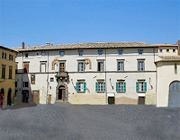

Walk I
Palazzo Clementini (1567)
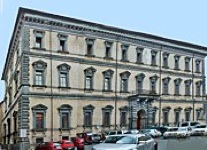
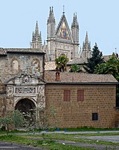
Monaldo Clementini commissioned Ippolito Scalza to build this palace, but it was still incomplete when Cornelio Clementi inherited it in 1577. Francesco Clementini left money in his will of 1687 for the completion of the facade. Nevertheless, photographs taken in the 19th century show that this facade was still barely started at that point.
The Commune bought the palace in 1912. It owes its current appearance to the "restoration" of the facade (1937) by Gustavo Giovannoni. If the main door is open, you can see the inner courtyard, with its fountain and lovely view of the Duomo.
The palace housed the Biblioteca Luigi Fumi until 2009. [It still houses the Liceo Classico ??]
Palazzo Crispo Marsciano (ca. 1536-80)
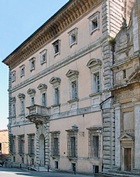
The future Cardinal Tiberio Crispo was inscribed as a noble of Orvieto in 1540 and became a canon of the Duomo. He commissioned Antonio da Sangallo il Giovane to design this palace: the design survives in the Uffizi Gallery, Florence, in a folio that also contains a design (ca. 1536) for a new ceiling for the nave of the Duomo. Construction was probably underway by 1543, but it seems that only the ground floor was complete when Antonio died three years later.
It seems likely that Raffaello da Montelupo, with whom both Tiberio Crispo and Antonio da Sangallo had close links, took over the project. There seems to have been a spurt in activity on it in 1551. However, the work subsequently proceeded intermittently, and the palace was still incomplete when both Tiberio Crispo and Raffaelo da Montelupo died in 1566.
Ludovico di Gasparo dei Conti di Marsciano bought the incomplete palace in 1586. The work he commissioned, which included the windows in the upper storeys, is attributed to Ippolito Scalza. The nuns of the adjacent convent of San Bernardino bought it in 1618.
The palace subsequently passed to the Commune. There are now plans to convert it into an archeological museum.
Palazzo Faina (1846-66)
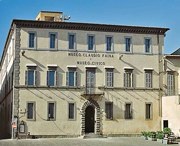
This was the site of a palace (13th century) that had belonged to the Monaldeschi family, which had been restructured in the 17th century. Count Claudio Faina built a new palace on the site, which subsequently passed to his son, Eugenio Faina. When Count Francesco Pallucco (who served in the first local government of Orvieto after its incorporation into the new Kingdom of Italy in 1860, and who was its mayor in 1871-3) sold Palazzo Buzi in 1885, he transferred its furnishings to Palazzo Faina, which then belonged to the his wife, Clelia Faina.
Both Claudio and Eugenio Faina were passionate archeologists. The latter provided the impetus for the two archeological museums that the palace now houses:
-
✴the Museo Civico; and
-
✴the Museo Claudio Faina.
Palazzo Febei (1580) in Piazza dei Febei
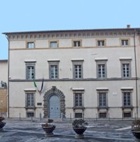
The palace then passed to Monsignor Francesco Maria Febei (1616-80), for whom the piazza is named. He was bishop of Bagnorea and subsequently [Abbot of SS Severo e Martirio ?] He was named as Archbishop of Tarsus in 1667.
The palace subsequently passed to a succession of Orvietan familes, the last of which was that of the historian and archivist Luigi Fumi. It now belongs to the Fondazione Cassa di Risparmio di Orvieto and was opened as an exhibition centre after restoration in 2004.
Palazzo Gualterio (16th century)
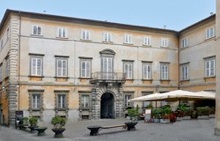
A design for Palazzo Gualterio by Antonio da Sangallo il Giovane survives in the Uffizi Gallery, Florence. It was probably built to this design by Simone Mosca: according to Giorgio Vasari, he “executed ... the ground plan and facade of the house of Messer Raffaello Gualtierio, father of the Bishop of Viterbo, and of Messer Felice, both noblemen and lords of great excellence and reputation”. (Raffaele and Felice Gualterio were respectively the son and nephew of Sebastiano Gualterio, who was bishop of Viterbo in the period 1551-66).
The palace, which was subsequently much modified, has two interesting portals:
-
✴The portal on Via Cavour, which is inscribed with the name of Trivulzio Gualterio, was added in ca. 1570.
-
✴The main portal was moved here towards the end of the 18th century from the family's newly-acquired Palazzo Buzi. The family evidently wished to place this more impressive portal in its more centrally located palace.
The family lived in the palace until the 19th century, when Filippo Antonio Gualterio (died 1874) lost the family fortune by contributing to the campaign for the unification of Italy.
The family's art collection is now exhibited in Palazzo Comunale. [The exhibits there also include an inscription that commemorates a stay by the exiled King James III of England in 1725, when he was a guest of Cardinal Filippo Antonio Gualterio (died 1728).]
Palazzo Saracinelli (1580)
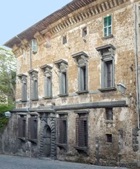
The windows on the first floor, which seem to have been built at different times, have inscriptions recording Pantaleone, Bernardino and Francesco Saracinelli.
Walk II
Palazzo Aviamonzi Alberici (16th century)
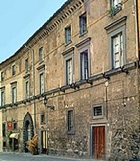
Palazzo Filippeschi Simoncelli (15th century)
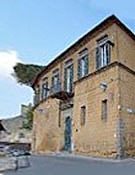
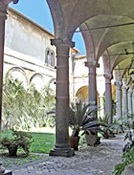
The Simoncelli family built this palace on the site of an earlier palace of the Filippeschi family. According to Giorgio Vasari, Bernardo Rossellino designed it.
At the time that Pericle Perali wrote his guide to Orvieto (i.e. 1919), this palace belonged to Giuseppe Petrangeli.
If the wooden door is open, you can see the elegant colonnaded courtyard within. A bifore window in the wall to the left (high up on the right) must come from the earlier palace.
Palazzo Mancini (16th century)
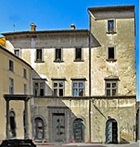
There is a series of lovely cruciform windows on the first floor.
Palazzo de’ Medici [date ??]
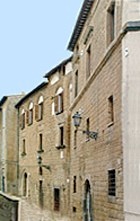
[Traces of an earlier 13th century palace]
Palazzo Ottaviani (ca. 1900)
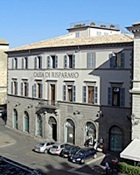
The palace was subsequently adapted to house the Locanda delle Belle Arti. Giuseppe Garibaldi stayed here when he visited Orvieto in 1867 on his way to Rome. The inscription in the façade says that enthralled the people when he spoke from the first floor balcony.
When the Cassa di Risparmio di Orvieto transferred to four rooms on the ground floor in 1885, the palace belonged to the Ottaviani family. It took on its present appearance in ca. 1900, by which time it belonged to the bank in its entirety.
Palazzo Ravizza (date ??)
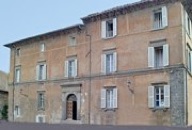
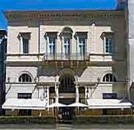
Facade in Piazza Vitozzi Facade in Piazza della Repubblica
This palace has its main facade in Piazza Vitozzi. It belonged to Monsignor Filippo Ravizza in 1857, the year in which he agreed to the reconstruction of its facade in Piazza della Repubblica: the Commune used the rooms here as offices. The reconstruction of this the neo-Palladian facade was effected in time for the visit of Pope Pius IX. Its design is attributed to Virginio Vespignani, and its construction was the work of his pupil, Giacomo Paniconi.
The building now belongs to the Cassa di Risparmio di Orvieto: it was linked to the bank’s adjacent Palazzo Ottaviani in 1999. The ground floor now houses Bar Il Sant' Andrea. The name of Filippo Ravizza is inscribed on the lintel of the main portal in Piazza Vitozzi.
Walk III
Palazzo Alberi (late 15th century)
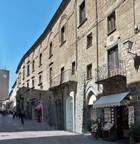
The palace was occasionally used as a residence of the papal governor.
Palazzo Aureli-Missini (1786)
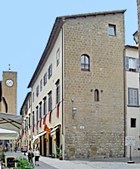
Palazzo Bracci (1875-81)
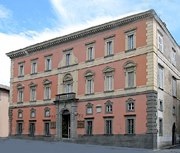
Virginio Vespignani built this neoclassical palace for Giuseppe Bracci Testasecca, the man responsible for financing the funicular railway of Orvieto. Towards the end of the century, the palace was adapted as Hotel Reale, where King Umberto I stayed in 1891.
Palazzo Febei in Corso Cavour (1660-70)
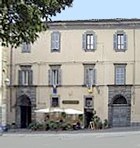
[The inscription on the architrave of the portal, “BIBLIOTECA PUBBLICA” refers to the fact that Monsignor Francesco Maria Febei made his library here available to the public. (He seems to have intended to donate the palace to the city, but subsequently changed his mind).]
Cardinal Febei also founded the Accademia dei Risvegliati (literally, the Academy of the Awakened) here in 1673. However, it foundered after his death in 1680 and was reformed in the early 18th century in Palazzo dei Signori Sette.
Palazzo Petrucci (1516-20)
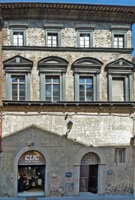
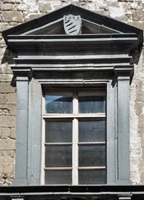
The Sienese Girolamo Petrucci commissioned this palace from Michele Sanmicheli in 1516. The façade was built in the 1520s. It was one of the first commissions in the 16th century revitalisation of the urban fabric of Orvieto.
The outer windows on the first floor have triangular pediments that bear the Petrucci arms.
Palazzo Simoncelli (13th century, restored 16th century)
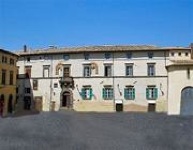
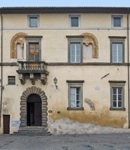
Giannotto Simoncelli restored Palazzo Simoncelli, which nevertheless incongruously preserves some elements of the original medieval building on its facade. Giannotto is commemorated in the architraves of a number of the windows.
The ornate window to the right of the portal commemorates his son Tiberio Simoncelli, who probably commissioned it. He also seems to have commissioned the balcony above the portal, which is attributed to Ippolito Scalza.
Return to Monuments of Orvieto.
Return to:
Walk I: Palazzo Clementi; Palazzo Crispo Marsciano; Palazzo Faina;
Palazzo Febei (in Piazza Febei); Palazzo Gualterio; Palazzo Saracinelli.
Walk II: Palazzo Aviamonzi Alberici; Palazzo Mancini; Palazzo de’ Medici;
Palazzo Ottaviani; Palazzo Ravizza; Palazzo Filippeschi Simoncelli.
Walk III: Palazzo Alberi; Palazzo Aureli-Missini; Palazzo Bracci;
Palazzo Febei (in Corso Cavour); Palazzo Petrucci; Palazzo Simoncelli.
